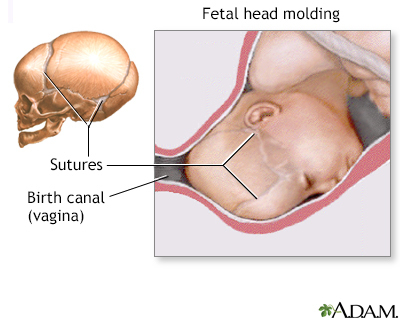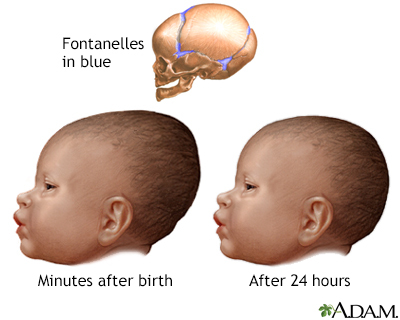Newborn head molding
Definition
Newborn head molding is an abnormal head shape that results from pressure on the baby's head during childbirth.
Alternative Names
Newborn cranial deformation; Molding of the newborn's head; Neonatal care - head molding
Information
The bones of a newborn baby's skull are soft and flexible, with gaps between the plates of bone.
The spaces between the bony plates of the skull are called cranial sutures. The front (anterior) and back (posterior) fontanelles are 2 gaps that are particularly large. These are the soft spots you can feel when you touch the top of your baby's head.
When a baby is born in a head-first position, pressure on the head in the birth canal may mold the head into an oblong shape. These spaces between the bones allow the baby's head to change shape. Depending on the amount and length of pressure, the skull bones may even overlap.
These spaces also allow the brain to grow inside the skull bones. They will close as the brain reaches its full size.
Fluid may also collect in the baby's scalp (caput succedaneum), or blood may collect beneath the scalp (cephalohematoma). This may further distort the shape and appearance of the baby's head. Fluid and blood collection in and around the scalp is common during delivery. It will most often go away in a few days.
If your baby is born breech (buttocks or feet first) or by cesarean delivery (C-section), the head is most often round. Severe abnormalities in head size are not related to molding.
Related topics include:
- Craniosynostosis
- Macrocephaly (abnormally large head size)
- Microcephaly (abnormally small head size)
Gallery



References
Ball JW, Dains JE, Flynn JA, Solomon BS, Stewart RW. Head and neck. In: Ball JW, Dains JE, Flynn JA, Solomon BS, Stewart RW, eds. Siedel's Guide to Physical Examination. 9th ed. St Louis, MO: Elsevier; 2019:chap 1.
Jones KL, Jones MC, Campo MD. Craniosynostosis syndromes. In: Jones KL, Jones MC, Campo MD, eds. Smith's Recognizable Patterns of Human Deformation. 8th ed. Philadelphia, PA: Elsevier; 2022:570-599.
Lissauer T, Hansen A. Physical examination of the newborn. In: Martin RJ, Fanaroff AA, Walsh MC, eds. Fanaroff and Martin's Neonatal-Perinatal Medicine. 11th ed. Philadelphia, PA: Elsevier; 2020:chap 28.
Walker VP. Newborn evaluation. In: Gleason CA, Juul SE, eds. Avery's Diseases of the Newborn. 10th ed. Philadelphia, PA: Elsevier; 2018:chap 25.